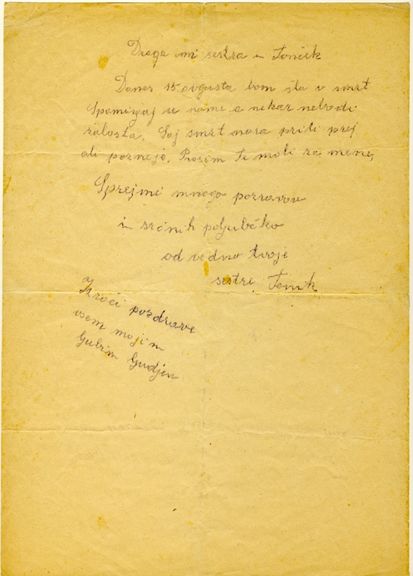Difference between revisions of "Stari Pisker Prison"
Ivan Pirnat (talk | contribs) m |
Anže Zorman (talk | contribs) (Updated 2020) |
||
| (21 intermediate revisions by 5 users not shown) | |||
| Line 1: | Line 1: | ||
{{Article | {{Article | ||
| − | | status = | + | | status = PHOTO |
| maintainer = Ivan Pirnat | | maintainer = Ivan Pirnat | ||
}} | }} | ||
{{Infobox | {{Infobox | ||
| − | | name = | + | | name = Stari Pisker Prison |
| − | | | + | | local name = Stari pisker |
| − | | | + | | logo = |
| street = Prešernova 20 | | street = Prešernova 20 | ||
| − | | town = | + | | town = SI-3000 Celje |
| − | | website = | + | | website = https://www.muzej-nz-ce.si/en/permanent-exhibitions/stari-pisker-the-memorial-space-for-the-victims-of-nazi-violence/ |
| email = mnzc@guest.arnes.si | | email = mnzc@guest.arnes.si | ||
| telephone = 386 (0) 3 428 6410 | | telephone = 386 (0) 3 428 6410 | ||
| fax = 386 (0) 3 428 6411 | | fax = 386 (0) 3 428 6411 | ||
| − | | | + | | managed by = Celje Museum of Recent History |
| − | |||
| − | |||
| − | |||
| contacts = {{Contact | | contacts = {{Contact | ||
| − | | name = | + | | name = |
| − | | role | + | | role = |
| − | + | | email = | |
| − | |||
| − | |||
| − | | email = | ||
| telephone = | | telephone = | ||
| fax = | | fax = | ||
}} | }} | ||
| + | |opening hours = 10am-2pm Tue−Fri, 9am−1pm Sat (advance notification necessary) | ||
}} | }} | ||
{{Teaser| | {{Teaser| | ||
| − | + | ||
| − | + | {{Image|Celje Museum of Recent History - Old pot -18.jpg}} | |
| + | |||
| + | |||
| + | [[Stari Pisker Prison|Stari pisker]] ("Old Pot") is a memorial site to victims of Nazi violence. The site is administered as a dislocated permanent exhibition of the [[Celje Museum of Recent History]], which holds torture and questioning devices and collection of moving farewell letters written by war prisoners held in the Stari pisker who had learnt they would soon be executed. | ||
}} | }} | ||
| + | |||
| + | When the building of the former Minorite monastery in the centre of Celje was reshaped into a penitentiary in the 19th century, locals gave it the name Old Pot. Prior to 1941 it had been used as a prison for women; during the World War II, German occupation forces used the site to commit many atrocities against civilians. In six out-of-court executions 374 hostages were shot in the yard, many others were tortured there. In December 1944 partisans attacked prison and freed 127 political prisoners. | ||
| + | |||
| + | In 1965 the prison was opened as a memorial site with a memorial courtyard and a memorial room in the former torture-chamber. It was later renovated in 1995. Today, the building surrounding the memorial's inner yard is still used as a re-education establishment for juvenile offenders. | ||
| + | |||
== See also == | == See also == | ||
| − | |||
* [[Celje Museum of Recent History]] | * [[Celje Museum of Recent History]] | ||
== External links == | == External links == | ||
| + | * [https://www.muzej-nz-ce.si/en/permanent-exhibitions/stari-pisker-the-memorial-space-for-the-victims-of-nazi-violence/ Stari Pisker Memorial web page] | ||
| + | * [http://en.wikipedia.org/wiki/Stari_pisker_Prison Stari pisker article on Wikipedia] | ||
| − | + | {{Gallery}} | |
| − | |||
| − | |||
| − | |||
| − | |||
[[Category:Monuments and sites]] | [[Category:Monuments and sites]] | ||
[[Category:Museums]] | [[Category:Museums]] | ||
| + | [[Category:Updated 2020]] | ||
Latest revision as of 13:08, 3 December 2020
When the building of the former Minorite monastery in the centre of Celje was reshaped into a penitentiary in the 19th century, locals gave it the name Old Pot. Prior to 1941 it had been used as a prison for women; during the World War II, German occupation forces used the site to commit many atrocities against civilians. In six out-of-court executions 374 hostages were shot in the yard, many others were tortured there. In December 1944 partisans attacked prison and freed 127 political prisoners.
In 1965 the prison was opened as a memorial site with a memorial courtyard and a memorial room in the former torture-chamber. It was later renovated in 1995. Today, the building surrounding the memorial's inner yard is still used as a re-education establishment for juvenile offenders.






